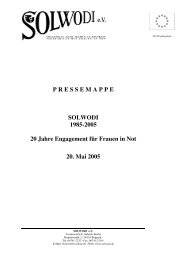Sponsored Vocational Training: Dream of Escape or Reality - Solwodi
Sponsored Vocational Training: Dream of Escape or Reality - Solwodi
Sponsored Vocational Training: Dream of Escape or Reality - Solwodi
Create successful ePaper yourself
Turn your PDF publications into a flip-book with our unique Google optimized e-Paper software.
Efficacy <strong>of</strong> SOLWODI’s <strong>Vocational</strong> <strong>Training</strong> Scheme 40<br />
International Centre f<strong>or</strong> Reproductive Health (ICRH), CEPED (www.ceped.<strong>or</strong>g) <strong>or</strong> by local<br />
<strong>or</strong>ganisations such as the Kenyan Salvation army church which assist CSWs. In addition, NGOs<br />
tend to prefer group-based rather than an individualistic approach, micro-loans f<strong>or</strong> groups instead<br />
<strong>of</strong> spons<strong>or</strong>ing VT f<strong>or</strong> one. King articulates in 1996 that ‘many NGOs have an almost inbuilt<br />
hesitation to help individual entrepreneurs’ (King, 1996: 179). Acc<strong>or</strong>ding to the NGOs Co-<br />
<strong>or</strong>dination Board in Kenya, there are currently fifteen registered NGOs operating with CSWs<br />
(see appendix). There is no <strong>or</strong>ganisation directly targeting SWs but SOLWODI. The maj<strong>or</strong>ity is<br />
centred on health facets. It can be speculated with a high probability that SOLWODI is amongst<br />
the min<strong>or</strong>ity w<strong>or</strong>ldwide which are engaging in the social aspects <strong>of</strong> CSWs, w<strong>or</strong>king directly in a<br />
developmental approach to SWs and are <strong>of</strong>fering inter alia spons<strong>or</strong>ed VT to them.<br />
5. Evaluation <strong>of</strong> SOLWODI’s <strong>Vocational</strong> <strong>Training</strong><br />
SOLWODI’s VT initiative <strong>of</strong>fers spons<strong>or</strong>ed VT to a very vulnerable group where lack <strong>of</strong><br />
money prevents them from gaining a vocational education. Reviewing the literature<br />
demonstrates that there are few programmes directly targeting CSWs in a developmental<br />
approach. Indubitably, SOLWODI’s attempts a high goal, trying to lift their clientele out <strong>of</strong><br />
poverty and out <strong>of</strong> the sex industry. F<strong>or</strong> this, SOLWODI looks also at the individual client, not<br />
only <strong>of</strong>fering group loans, but in particular seeking to individualise success by spons<strong>or</strong>ing<br />
training to a single person. My research shows that SOLWODI spons<strong>or</strong>ed VT to 389 young<br />
women in the last ten years, <strong>of</strong> whom 23 percent are currently w<strong>or</strong>king in their trained crafts.<br />
M<strong>or</strong>e than half <strong>of</strong> SOLWODI’s trainees received training as Hairdressers/ Cosmetologist.<br />
Gender-stereotyped crafts such as Hairdressing, Dressmaking, and Childhood Studies are the<br />
courses where most <strong>of</strong> the women train in. There are some who have ventured into male<br />
dominated trades such as Car Mechanics, Electrical Wiring, but those only represent 3 percent.<br />
Master craftsmen interviewed in an ILO/ IPEC Kenyan study on VT in 2006 indicated that<br />
several fact<strong>or</strong>s hinder girls from joining the traditional male dominated sect<strong>or</strong>s. These are:<br />
cultural practices (45 percent), societal attitudes (36 percent), lack <strong>of</strong> inf<strong>or</strong>mation and awareness<br />
(3 percent), lack <strong>of</strong> fees f<strong>or</strong> training (2 percent) and others, e.g. lack <strong>of</strong> opp<strong>or</strong>tunities (13 percent)<br />
(Mutie, 2006: 43). The maj<strong>or</strong> push-out fact<strong>or</strong> f<strong>or</strong> the small number <strong>of</strong> cases where it is known<br />
was pregnancy. The interviewees in this research signalised that also poverty, trying to make<br />
ends meet, peer pressure, lack <strong>of</strong> motivation and devotion play a crucial role why trainees quit.<br />
Ngware (2002) confirmed that the maj<strong>or</strong>ity abandoned VT because <strong>of</strong> financial problems.






